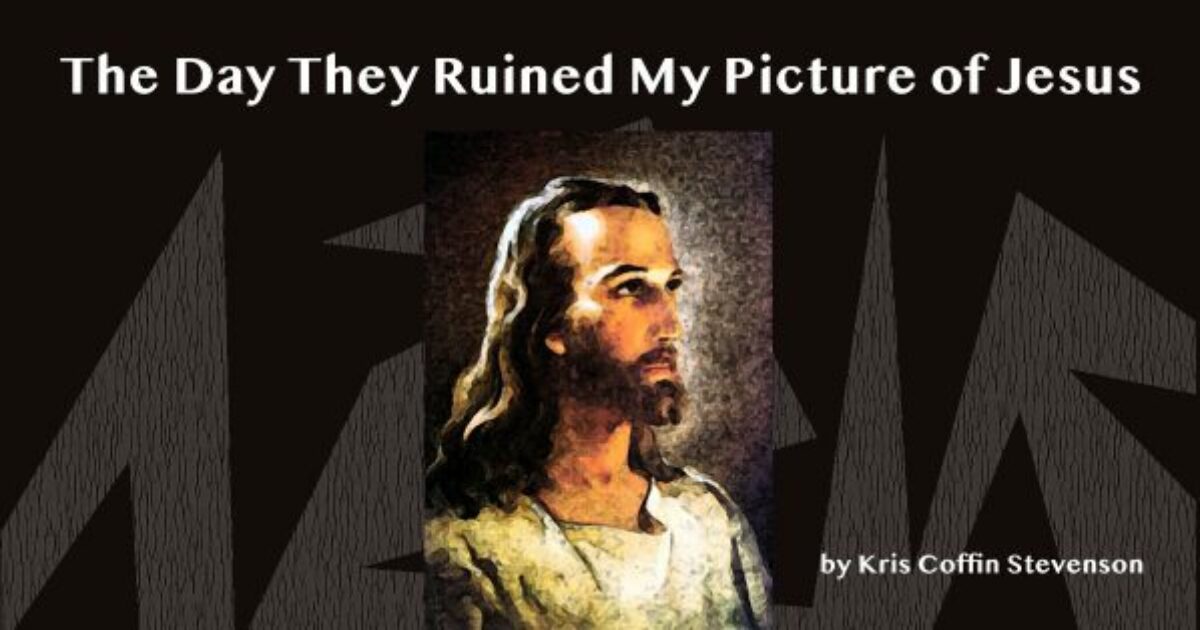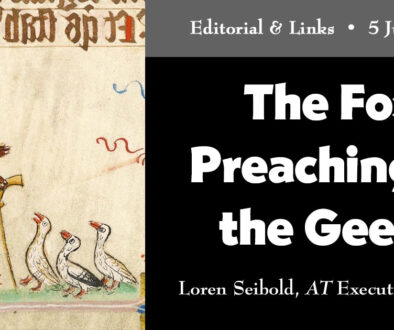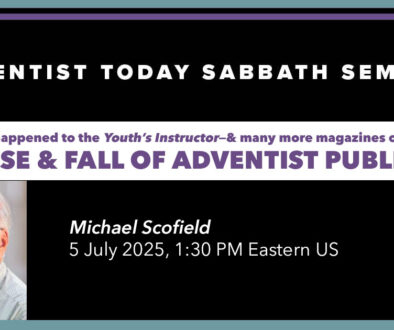The Day They Ruined My Picture of Jesus
By Kris Coffin Stevenson | 7 December 2018 |
It was the children’s fault that my picture of God was ruined. If they hadn’t gotten their smeary fingers on it, it might have stayed exactly the way I envisioned it.
And that would have been worse.
All of this paradigm-shifting happened when I attended a seminar about how the Spirit of God is calling people from all races, religions, and cultures into a closer relationship with God. The organizer of the seminar sought to be innovative by having an artistic “work-in-progress” on the platform that would be created as the presenter was speaking. He asked me to oversee the artwork and, since I felt my artistic skills weren’t up to working onstage with hundreds of eyes boring into my back, the idea was cultivated that a basic outline of a picture would be made on a canvas and everyone could participate in making the art.
With this end in mind, the organizer found a picture online of a modern-day Jesus standing on a New York City street wearing jeans and a jacket. I set up a projector and fed the image through it from a laptop so I could project the image onto a canvas about 3’ by 4’. With a pencil I sketched the outline and the details of the picture and added the caption “Jesus Is on the Move.”
The Friday evening meeting got underway with a brief announcement that the picture was available for anyone to paint. The organizer had bought big containers of acrylic paints; red, blue, yellow, sienna, black and green. A tarp covered the platform carpet under the easel, and a bucket of water and some assorted paintbrushes and paper plates for mixing colors were arranged carefully before it.
The presenter first spoke about his conversion from Islam to Christianity and how his parents had opposed this bitterly, eventually bringing in a high-ranking Muslim sheik to try and straighten him out. To everyone’s surprise the sheik requested to speak to him alone and, instead of trying to detach him from Christianity, actually encouraged him in his desire to grow closer to God. The speaker went on to make the point that when he speaks to people of other faith, he doesn’t start with an agenda of conversion, but seeks to listen to them and to assist them in their spiritual growth.
During the presentation, the canvas sat empty on the side of the stage, the picture of Jesus just a faint outline. No one dared venture forward to dabble in the tempting paints. “Oh well,” I thought. “I guess I will be forced to get up there tomorrow and finish the painting.” The thought of standing up there attempting to paint while the whole crowd critiqued my actions brought shivers down my spine. But the picture of Jesus needed to be finished and I would have to be responsible to do it if no one else more artistically inclined than I was stepped in.
The next morning, after a good night of sleep, everyone showed up with more bounce in their step. To my surprise, someone had filled in a bit of the lettering, presumably after the meeting had finished the night before. The colors were yellow and red. “A bit basic,” I huffed to myself. “But I can work with that.”
The meeting began with another call to participate in the painting. But all through the first presentation of the day, the canvas sat idle with only the words “Jesus is on the move” clearly visible. “This is it,” I thought. “I’m going to have to get up there and finish it.”
During the next break, I went up and began fussing with my painting. I got some paper plates and mixed up some colors. I decided to start with the crown of thorns. That would be a fairly innocuous beginning and easily fixed if I messed it up. With a couple of brown colors, I began filling in the thorns. As I was painting, several people came up to watch. I invited them to participate, but they all hung back. But several children pressed closer, intrigued by the bright paints. My husband encouraged them to pick up paintbrushes. I had some serious doubts about this, but he helped them to mix up some blue and begin painting the jacket. With a watchful eye on the children’s progress, I finished up the crown of thorns. The crown didn’t look too bad, I thought to myself. It was realistic and not too stiff. The jacket however, was definitely falling into Impressionism. But I figured it could still be fixed. The children had painted it a haphazard blue and attempted to leave spots where I had outlined variations in color. They didn’t get the chance to finish the whole jacket before the meeting resumed, so the right section kind of faded out into the blank canvas.
With another seminar segment about to start, we all took our seats. The presenter talked about how to love all kinds of different people. The painting now had some color and life, but the face was still missing. In my seat I fidgeted as I watched it. The face was going to have to be worked on, but I knew that that was the hardest part and my artistic skills didn’t stretch to faces. I had asked that the original image be available on the laptop so that people could refer to it as they painted. However, the laptop was needed elsewhere, so only the organizer and I had ever seen the original image. Without the picture to copy, I knew it was going to be extremely difficult for me to paint the face. I sighed. It was time for me to expose my artistic weakness to the congregation.
Suddenly, a woman arose from the congregation as the presenter was speaking and made her way to the easel. The audience watched, transfixed, as she began mixing paint. She spent a long time on this process and eventually began to paint a flesh tone onto the face. I sighed with relief. This woman knew what she was doing. The flesh tone was dark enough to denote Jesus’ Jewish heritage, I thought, but not so dark as to stray into political correctness. It was a healthy color, not a sickly green, or a pasty white. She colored in his features–nose, mouth, eyes, eyebrows. When she was through, the face looked like a face, although it was missing some detail and expression.
During lunch as everyone was milling about, I went up to the balcony and happened to glance down at the painting. The effect was astonishing. From that distance, it appeared that Jesus had blazing white hair and beard. The unfinished jacket actually gave a similar appearance to the famous unfinished Gilbert Stuart portrait of George Washington. The whole effect was certainly unusual, but it was attractive and definitely biblical. I recalled the text from Revelation 1:14 where the Son of Man’s hair is described as white as snow or wool.
When I came back into the meeting hall at the start of the afternoon session, I was in for a shock. Someone had allowed the children unsupervised access to the painting. Now the background was bright red, the jacket had been painted a dark, solid blue, and the shirt, which was supposed to be white with a small, blue print, now looked like the 1960s had run amok on it with red and yellow swirls. But the worst thing of all was the crown of thorns. My realistic rendition of the thorns had been covered over with thick, black paint making the top of Jesus’ head look like he was wearing a fur Russian beaver hat in preparation for a Siberian winter.
I was crushed. I sat in my pew listening to the speaker talk about how if you love more you have less control; there’s no love without letting go. At the same time I was trying assiduously not to look at the ruined painting. But like a rubbernecker at a bad accident, my eyes kept straying to the horrifying mass sitting on the top of Jesus’ head. Why hadn’t we kept a better watch over the painting during lunch? Where were these kids’ parents when they were desecrating Jesus? What were the kids thinking? Painting a red background around red letters didn’t even make sense! And the jacket! The children had misinterpreted my lines that showed highlights in the color to be the cutouts for his elbows. As a result his arms were completely lopsided! But the worst heresy was the crown of thorns. There were no words harsh enough to describe the jumble that the crown of thorns had turned into. I wasn’t sure it could be fixed. Why, oh, why had these kids messed with my picture of Jesus?
My affronted thoughts stuttered to a halt. My picture of Jesus? What was I saying? This wasn’t my picture. I didn’t own it. I had even refused the offer to paint it myself! Time after time it had been announced from the front that anyone could come and contribute to the painting. The children weren’t maliciously destroying the painting. They were honestly painting their idea of Jesus based on what I had sketched for them. How could I set some sort of standard that they had to meet? What next? Would I screen potential painters before letting them near the image? Would I demand to see a portfolio of work, a certificate of an educational degree? Would the audience vote on who was allowed to approach the painting? Would we set up a committee to elect a committee to choose those who would paint? Would we assign parts of the painting to those who cleared all the hurdles?
I bowed my head in shame. “God,” I whispered. “This is You. This is You being revealed to your people through the eyes of all of us. Forgive me for wanting to control the picture of You; to own it; to not want to share the joy of creating it with others.”
I never worked on the painting again. I didn’t have to. For as the afternoon wore on and our speaker talked about how we need to become re-enchanted with God, a stream of people rose out of the audience and approached the painting; young and old, male and female, Jew and Gentile, slave and free. With each round of paint, the image changed. It was never finished; it was never not finished. Each time someone worked on it, it became something new—a fresh perspective on the character of God. Sometimes I liked it, sometimes I didn’t. But it was always a genuine representation of how someone viewed God.
During one break, a man watching by the platform lamented that he didn’t have any artistic talent, but that he really wanted to contribute to the picture. I encouraged him to find some way of being included. After a moment’s thought, he picked up a paint brush and painted a peace symbol on Jesus’ jacket. Another man who was also just standing and watching, suggested that Jesus needed a poppy. It was the weekend of Remembrance Day in honor of Canadian veterans (Veterans Day in the U.S.), and everyone was wearing poppy pins as a symbol of the blood shed “in Flanders Field.” I looked out into the audience and saw an elderly gentleman sitting by himself, wearing a poppy pin. I asked him if he would mind if we used his poppy pin as a model from which to paint one on the jacket. Without a word he opened his coat, took a plastic bag filled with poppy pins from an inside pocket, and handed me one.
As the speaker wrapped up the weekend-long presentation, the final two artists worked feverishly to finish the painting, outlining the red letters so they stood out against the red setting and filling in the background with the skyline of New York and Lady Liberty. The mass on Jesus’ head had shrunk and grown some thorns—it looked more like a traditional crown of thorns now—but there were still remnants of the children’s vision in the painting.
I think if we had met all week, the image would have continued to change the entire time; each vision complete in itself.
The weekend had been full of surprises. We had been challenged to love deeply and indiscriminately, to encourage all people in their spiritual journey and not just view them as potential converts, to let God be God and to keep our eyes focused only on Him.
I knew my image of God would never be the same, nor would the image of any of those people who had made the trip down the aisle and up the steps to kneel before Him, paintbrush in hand. Even the children. Especially the children.
Dear Adventist Today readers: I’m inserting this note to tell you that we are right now conducting our end-of-year fundraiser. Adventist Today is largely a volunteer organization, but if we’re going to continue to provide you with stimulating news—often news you get nowhere else—and fascinating commentary by some of the best writers in the denomination, we do need some financial support. If you want to see us continue to do the journalism that you’ve been accustomed to from Adventist Today, would you follow this link and give us a gift now? Loren Seibold, Executive Editor, Adventist Today website and magazine.
Kris Coffin Stevenson is an author, teacher, editor, and scopist. She loves living her eternal life starting now. She and her husband reside in Santa Clarita, California.




